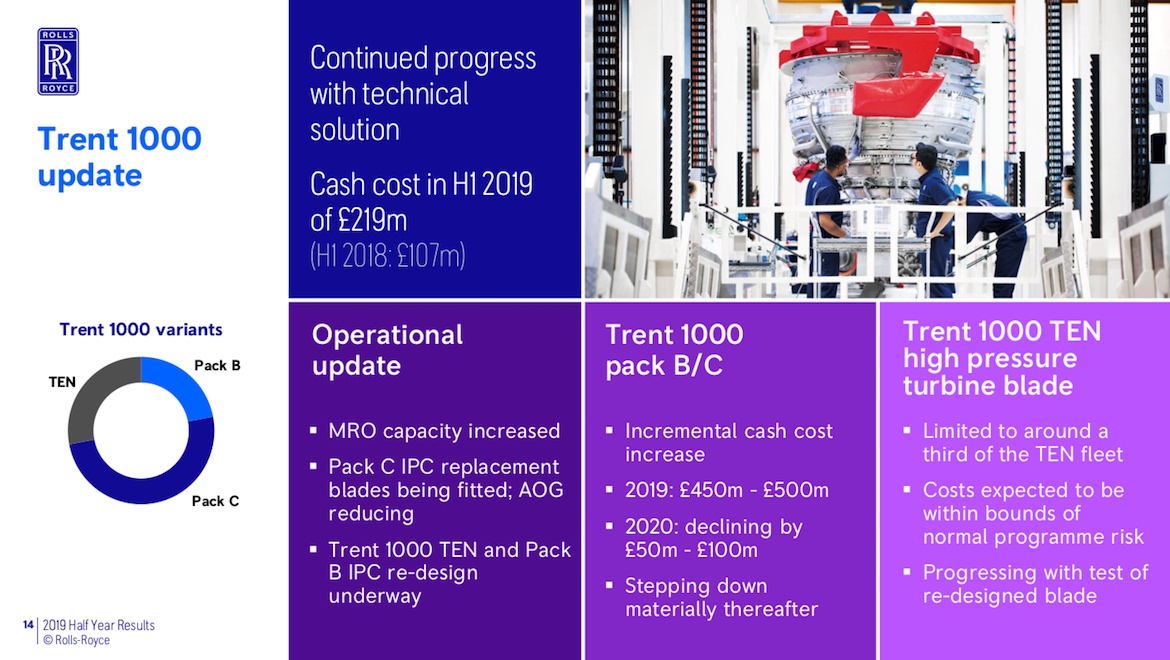
Rolls-Royce says the number of Boeing 787s impacted the Trent 1000 engine issue will remain in the double-digits until at least the second quarter of 2020.
The engine maker had previously targeted having fewer than 10 aircraft on the ground (AOG) due to the Trent 1000 engine problem by the end of calendar 2019.
However, it said in a statement on Friday (European time) this would now occur in 2020.
Rolls-Royce said the delay was due to additional maintenance, repair and overhaul (MRO) load “resulting from from faster deterioration of the high pressure turbine (HPT) blade on the Trent 1000 TEN”.
Further, the company said it had also taken, since August, a “proactive decision to accelerate intermediate pressure turbine (IPT) blade replacement for the limited number of Package B and C engines yet to be fitted with the final standard of IPT blade”, which had led to additional engine removals.
“As a result, though we continue to work on further increasing our MRO capacity, these challenges mean that we now expect the return to single-digit level of AOGs on the Trent 1000 to be delayed until Q2 2020,” Rolls-Royce said.
“We deeply regret the additional disruption that this will cause our customers and we continue to work closely with them to minimise the impact on their operations.”

Rolls-Royce chief executive Warren East had indicated at the company’s calendar 2019 first half results presentation in August the additional load placed on the company’s MRO facilities had extended some turnaround times and placed the end-of-the-year target at some risk.
“It is possible we’ll get there for the end of the year, but it’s also very possible that the polluting effect of the TEN will cause that to delay a bit longer,” East said.
“And that, unfortunately, is where we are. I’m still pleased with the progress we’re making on managing and fixing all these issues, but the reality is that we’ve still got a lot of hard work to do before it’s out of the way.”

In April 2018, the US Federal Aviation Administration (FAA) issued an airworthiness directive (AD) that limited extended operations for Boeing 787s with Rolls-Royce Trent 1000 engines due to some durability issues on the intermediate pressure compressor (IPC) rotor blade for Trent 1000 Package C engines.
In terms of a long-term fix to the problem, Rolls-Royce has redesigned IPC rotor blade for Trent 1000 Package C and Trent 1000 TEN engines.
Also, Rolls-Royce has said previously regulators recently changed a hard life limit on a compressor drum on the Trent 1000 TEN engines to an inspection regime, which had also helped reduce the disruption to airlines.
Air New Zealand’s five 787-9 aircraft with the Trent 1000 Package C engines were knocked out of service by the blade issues, then eight with replacement Trent 1000 TEN engines required inspections sooner than expected earlier in 2019.
Singapore Airlines and its low-cost carrier (LCC) unit Scoot, among other airlines, have also faced disruptions due to the problem.











